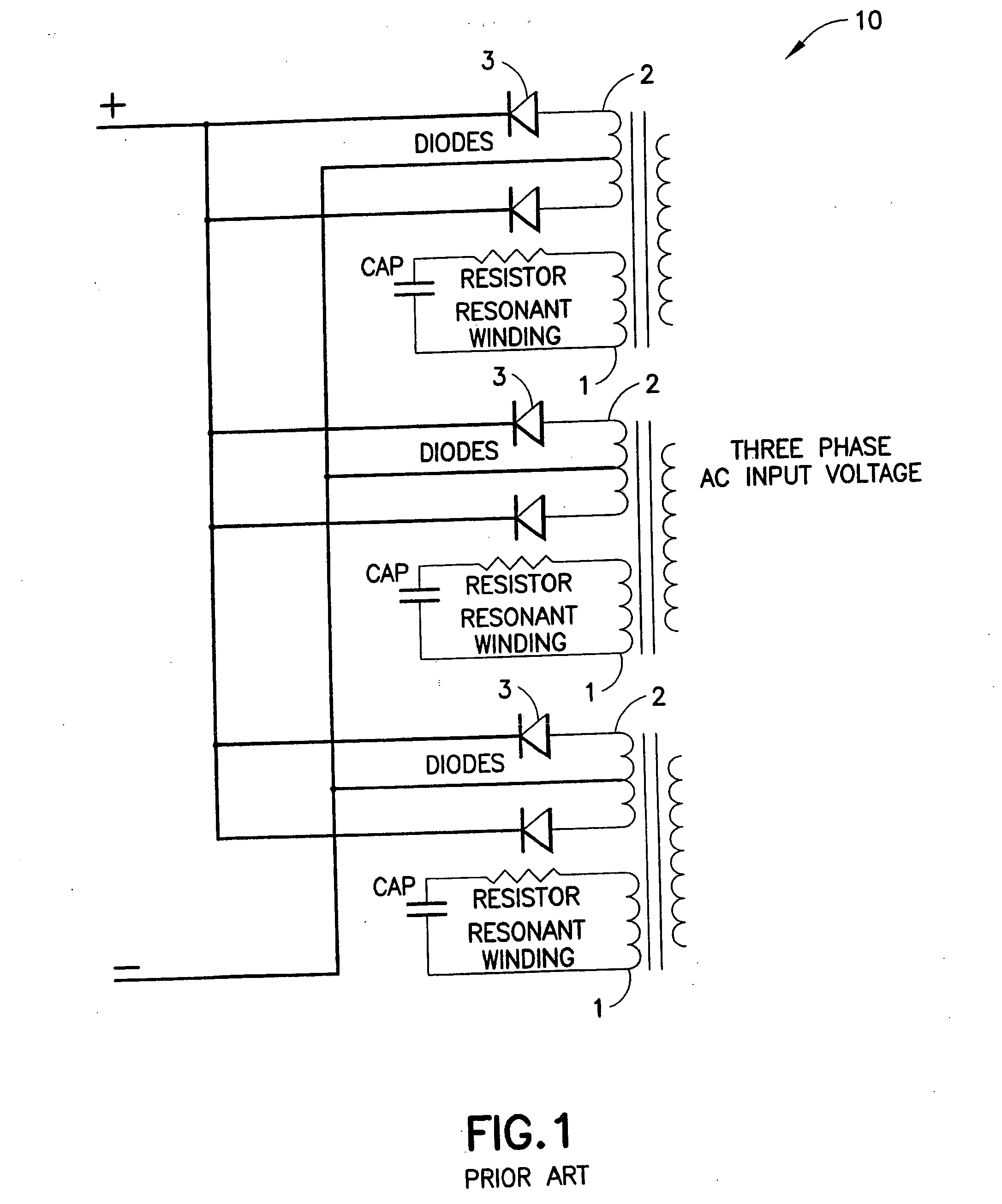Fast charger for high capacity batteries
a high-capacity battery and fast charging technology, applied in the direction of charge maintainance charging/discharging, sustainable buildings, transportation and packaging, etc., can solve the problems of increased capital expenditure, significant inconvenience of users of high-capacity batteries, and loss of employee tim
- Summary
- Abstract
- Description
- Claims
- Application Information
AI Technical Summary
Benefits of technology
Problems solved by technology
Method used
Image
Examples
first embodiment
In a first embodiment, the pulse width modulation used to provide the output power is itself modulated in response to the 360 Hz rectified 3-phase AC input waveform. As the ripple from the 360 Hz rides largely unfiltered on the DC bus, the PWM duty cycle is synchronously varied in proportion and accordance with the AC ripple voltage. As the AC voltage increases, the PWM is decreased in order to accommodate the higher input voltage and is correspondingly increased when the AC voltage decreases in the 360 Hz DC bus ripple sinusoidal waveform. This is accomplished by continuously monitoring the output or input voltage ripple to the controller and adjusting the drive PWM on a pulse-by-pulse basis. As the voltage increases on the DC output of the converter, the PWM duty cycle is reduced and as the voltage decreases on the DC output the PWM duty cycle is increased. This effectively removes the 360 Hz AC ripple component on the DC bus input from the voltage output of the converter and prov...
second embodiment
In a second embodiment, a 15 kHz rate every pulse triggers an interrupt service routine (ISR). In this routine, the output voltage, VOUT, is read. If VOUT is too high the PWM is decremented by 1 and the ISR is terminated. If VOUT is at or below VOUTNOM desired the current is then measured. If the current is above 125% Imax the program immediately decrements the PWM and exits the ISR. If the current is below or equal to 125% of INOM the PWM Ramp delay is examined and if equal to zero the ramp delay count is reloaded and the PWM is decremented by one before exiting the ISR. If the ramp delay is not equal to zero, the ramp delay is decremented and the ISR exited. If the current is below a desired level the ramp is delayed and the ramp delay count must be zeroed before the PWM can be incremented. If the current is as desired, the ISR is exited immediately and no change in the PWM count is made.
FIG. 12 is a flow chart illustrating a second control technique for the fast charger of the in...
third embodiment
In a third embodiment, the output voltage and current are continuously monitored and prevented from exceeding desired values while at the same time allowing the passing of the 360 Hz AC ripple current and voltage, created by the input rectification process, by the use of one or both of the following techniques. The voltage and current values are filtered in an analog circuit which averages their value over the 360 Hz rectified input cycle and prevents control reaction to small variations within this 2.77 mS time frame. The PWM output circuit in the microprocessor is prevented from reacting to minor variations in the output voltage and current by numerical methods and / or limiting the adjustment frequency of its control response.
FIG. 14 is a flow chart illustrating a third control technique for the fast charger of the invention, and FIG. 15 is a software listing for the third control technique shown in FIG. 14.
As shown in the drawing of FIG. 14, *RDC is ramp delay count, CC is const...
PUM
 Login to View More
Login to View More Abstract
Description
Claims
Application Information
 Login to View More
Login to View More - R&D
- Intellectual Property
- Life Sciences
- Materials
- Tech Scout
- Unparalleled Data Quality
- Higher Quality Content
- 60% Fewer Hallucinations
Browse by: Latest US Patents, China's latest patents, Technical Efficacy Thesaurus, Application Domain, Technology Topic, Popular Technical Reports.
© 2025 PatSnap. All rights reserved.Legal|Privacy policy|Modern Slavery Act Transparency Statement|Sitemap|About US| Contact US: help@patsnap.com



